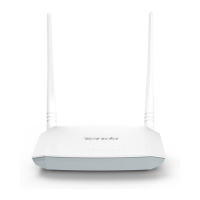53
Step 1 Click Add.
Step 2 Select FTP that you wish to host on your network from the Select a Service drop-down list. The port
number (21) used by this service will then be automatically populated.
If you wish to define the service yourself, enter a descriptive name in the Custom Service, say My FTP, and then
manually set the port number (21) used by this service in the Internal Port Start, Internal Port End, External Port
Start and External Port End.
Step 3 Select a protocol from the Protocol drop-down list. If you are unsure, select TCP/UDP.
Step 4 In the Server IP Address field, enter the last digit of the IP address of your local computer that offers
this service. Here in this example, we enter 192.168.1.100.
Step 5 Click the Apply/Save.
--End
Remote Access:
Your friends can access your FTP server by entering "ftp://183.37.227.201" in the address bar of a web browser.
4.6.2 Port Triggering
Some applications, such as games, video conferencing, and remote access, require that specific ports in the
router's firewall be opened for access by the applications. Port Trigger dynamically opens up the 'Open Ports' in
the firewall when an application on the LAN initiates a TCP/UDP connection to a remote party using the
'Triggering Ports'. The Router allows the remote party from the WAN side to establish new connections back to
the application on the LAN side using the 'Open Ports'.
Choose Advanced> Advanced Setup > NAT > Port Triggering to enter the configuration page.

